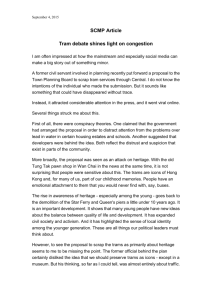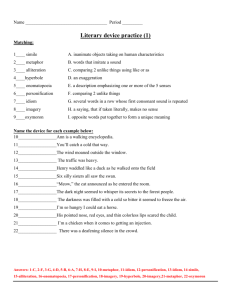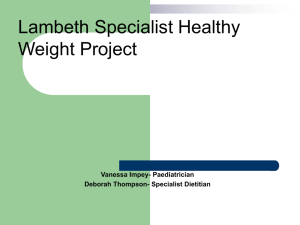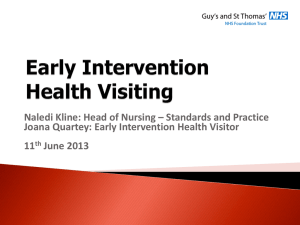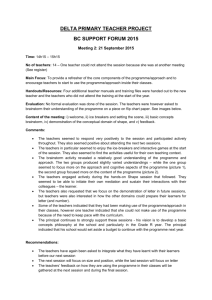Sancroft Street in 1935 - HOME
advertisement
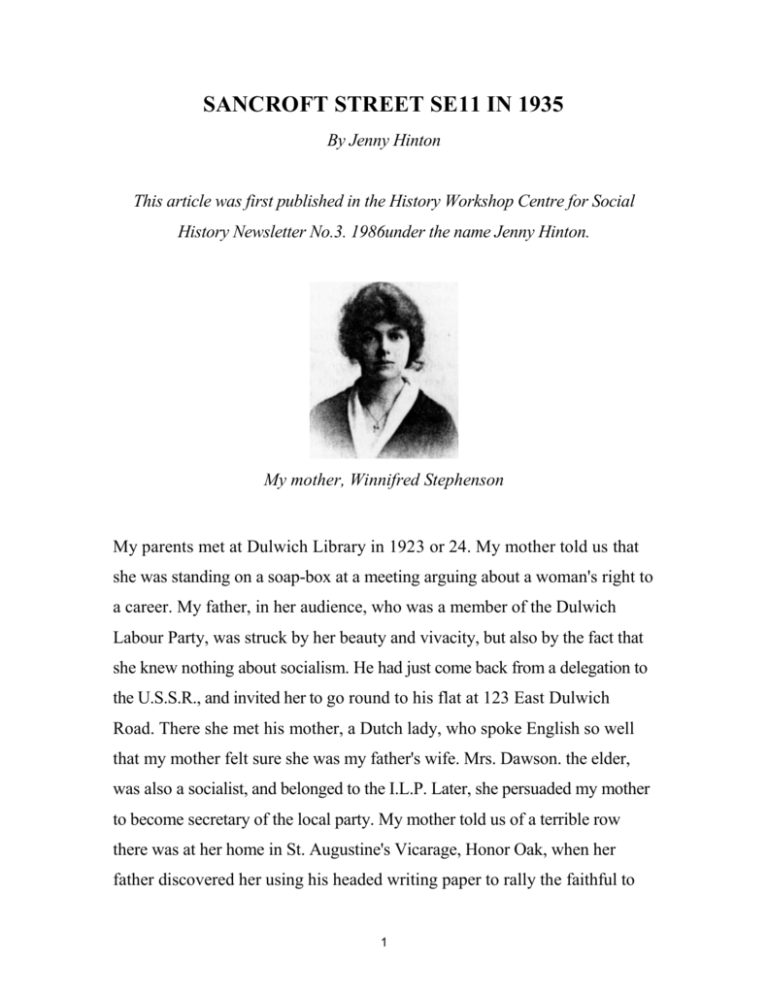
SANCROFT STREET SE11 IN 1935 By Jenny Hinton This article was first published in the History Workshop Centre for Social History Newsletter No.3. 1986under the name Jenny Hinton. My mother, Winnifred Stephenson My parents met at Dulwich Library in 1923 or 24. My mother told us that she was standing on a soap-box at a meeting arguing about a woman's right to a career. My father, in her audience, who was a member of the Dulwich Labour Party, was struck by her beauty and vivacity, but also by the fact that she knew nothing about socialism. He had just come back from a delegation to the U.S.S.R., and invited her to go round to his flat at 123 East Dulwich Road. There she met his mother, a Dutch lady, who spoke English so well that my mother felt sure she was my father's wife. Mrs. Dawson. the elder, was also a socialist, and belonged to the I.L.P. Later, she persuaded my mother to become secretary of the local party. My mother told us of a terrible row there was at her home in St. Augustine's Vicarage, Honor Oak, when her father discovered her using his headed writing paper to rally the faithful to 1 the 'godless, atheistic socialist cause.' My parents' marriage in 1925 created another crisis, and another was the General Strike of 1926, when my mother's brother came down from Cambridge to drive a train for the strikebreakers. I can't remember my father and uncle ever speaking to each other, or about each other, except in jest. My mother's parents were eventually reconciled to their daughter and her children, though not to our religion or politics. My mother had been brought up in a harsh puritanical Christianity, where life was a vale of tears. 'Ever since I discovered it was not a vale of tears, one day on London Bridge when I had just got my first job, I have been in love with life,' she told me. Such was my family. We moved to Sancroft Street in 1935, when I was six years old. It lies between Kennington Oval and St. George's Circus, between Waterloo Bridge and Vauxhall Bridge. My father was working for the Workers' Travel Association, a socialist travel agency, set up after the First World War, to help workers of all lands to know each other better. The offices then were in Transport House, Smith Square, SW1, and he used to walk to his office every morning down Princes Road (now Black Prince Street) and over Lambeth Bridge. Sometimes on Saturdays I used to walk with him, and later was told I had been introduced to Herbert Morrison, whose blocks of workers' flats were already being built in South London by the L.C.C. The Thames had a lot of traffic on it - strings of coal lighters trailing up and down. tugs, refuse-lighters, and I also remember a ship unloading grain by the Hovis factory and a wooden Thames sailing barge, with a menacing red- 2 brown sail making a thrashing noise as it heeled. Portland Cement was written on the sail and I couldn't bear to drag myself away. Further down the river the Batavier Line ships were moored, and at Hayes Wharf, where my father had started his working life, a ship sailed for Amsterdam every week. My parents had been to Northumberland for their honeymoon, by ship from Limehouse to Newcastle, and had been afraid of the Chinese in that part of the East End when they embarked. A girl at school once invited me home, and the end of her street in Millwall was blocked by the bright yellow funnel of a steamer. The banks of the river seemed like a forest of bare branches — the masts of old Napoleonic ships? There were certain places where children could play on the embankment steps. At Tower Steps and Greenwich, children would bathe, but we once found a dead rat, very mauve and white, and it put us off. We used to paddle in the L.C.C. paddling pool at the Oval, and go to the swimming baths where there were sometimes special shallow pools for women and children. A mauve ticket said One Woman's Swim to distinguish it from the slipper-baths, which stood in big wooden frames. They gave you a grey calico towel with the name of the baths embroidered in bold red right down the middle. They also sold yellow soap. These public baths (there was one behind us in Lambeth Walk) were almost as magical to me as the river. You learned to swim with a grey log of wood tied to a rope. We had come back to London from Hertfordshire. Both my parents were Londoners born and bred. Welwyn Garden City had been uncomfortably full of well-spoken people who had singing lessons and went about with bare feet, so London was a terrible as well as a desirable discovery. The smells, 3 the fog. the rough people, the poverty, disease, noise... the discovery that our family was of no significance, and that our accents were the only noticeable things about us; but more important, the discovery not only of death, but. by 1936. of war and bombing. But before we had heard the word 'indiscriminate' used of Franco's raids on Madrid, the thing that astounded us was the tall buildings and the number of stark imperative statements hanging above our heads especially at night in the dark, such as Get Younger Every Day. which baffled me as it hung at the end of Kennington Road, especially as my grandmother seemed indifferent to its instructions. There was very little traffic on the side-streets, and we used to play a game called 'Blindey'. in which we took turns to blindfold each other and lead them to some new discovery. Parliament Street was made of butcher's brawn (the pink marble of the shipping offices with their brass-plating and huge model cruisers taking up the length of the office windows). Central London seemed to be a tunnel lined with marble, polished brass, glittering mica stone, and luminous tiles, usually decorated with mosaics. It was a highly decorated place. The underground lavatories were palaces of brass, mahogany and shiny brown tiles that were head high. They were incandescent, and the roofs were made of glass, and you could see people walking above you. A 'nelly', as we called the attendants, always had a little sitting room at the bottom of the brass- 4 railed steps. She was usually knitting, and a kettle was boiling on her gas-ring. You could have a wash-and-brush-up for fourpence in a solemn room at the end which she unlocked personally. My mother would always stop for a talk. Inside each lavatory there was a list of V.D. clinics, and a guarantee that patients were seen in strict confidence. Such lists struck me as the only gloomy part of this underworld. I asked my mother what a lying-in hospital was, and what the Home for Fallen Girls was. The water in underground 'conveniences', as they were called, came out of tiny, reassuring brass taps (which I used to call 'ladies' slippers'), and was scalding hot. The soap was browny yellow, and so full of soda that it hurt your face. When noone was looking, you could climb into the roller towel, and swim or swing. We lived in a very respectable block of Victorian flats. Ours was on the first floor, and you reached it by stone steps glittering with mica. Some people put their names beside their front doors. Welwyn Garden City seemed to have been built for children. Here we discovered that children were disliked by adults, and of little importance. A friend invited me to her flat, and I realised that hers was a tenement. The washing went right across the yard from one block to the opposite one, whereas ours was hung out individually on the fire-escapes. Her public stairs smelt different. Children played on them, and there were harsh notices pinned up about Rent Arrears and Ball Games. My parents belonged to that class of people which is the despair of advanced capitalism. We weren't poor compared with our neighbours, and therefore not an object of mercy or a political problem. We had sufficient. We were never cold or hungry or deprived. Our standard of living was very simple, so we 5 weren't interested in saving, or acquiring, or competing financially or improving ourselves socially. My parents were the contented people that occasionally jam up the flow-process of consumerism. Clothes were handed down. We always lived in rented accommodation. Frank Dawson and Kitty Dawson, my father and his mother. My mother had the same amount of housekeeping money each week, and when she totted up her shopping bills at the end of the week, after food she used to write 'sundries'. This sum was very small and unchanging. On Fridays she bought a 2 oz. tub of United Dairies cream, and we had a banana each. After we had gone to bed on Fridays, my parents went to the local, but I can't remember them drunk. My father had a pipe, and smoked it about once a day. We had no car or fridge or wireless. Once my godmother took us for a drive in her car. but I can only remember that the windows were made of brown 6 gelatine, and fell out when you touched them. The car had a running board, and we stood on it when she tried to drive away. We had a Murdoch upright piano and a gramophone that looked like a wooden bedside locker. You wound it up with a black handle, and it ran for about three minutes. Under the turntable there was a shelf for about ten 78 records. We had 'In A Monastery Garden' and a few waltzes and fox-trots. On the bookshelf was Enquire Within, The Wonderland of Knowledge, some Conrad, Bernard Shaw and a few Left Book Club books. My parents stayed in the rented sector without car or fridge or TV till about 1957. My mother, as a vicar's daughter, was not used to housework, so she usually had help in the flat. But we children were afraid of these Lambeth women cleaners. They were all very fat or very thin, and they all seemed so ill. I remember one who used to wrap her varicosed legs in cabbage leaves. Her legs were always bare, and she always wore gym shoes and a cotton dress. She carried a bag made of squares of India-cloth machined together and she always kept this bag secret. I think even my mother was afraid of her. She would never eat with us, and never ate our food, or any fresh food. My mother was very permissive. She had been given china and silver for her wedding, but as she believed that property was theft, she had allowed most of this to disappear before we arrived in Sancroft Street. Consequently most of our china and cutlery was from the tupenny bazaar in Tracey Street. My parents didn't have a matching set of cups and saucers till about 1956, I think. Our dining room looked out over an asphalt yard and the back of Princes 7 Road. A wilderness of slum streets and derelict, tottering houses - Lollard Street. Hotspur Street. Huss Street - separated us from Waterloo. We used to go to and from school through these streets, and they smelt of rats and damp and sweet bugs. Plaster and lath bursting out of collapsed and derelict rooms had a peculiar smell, which I was reminded of again during the blitz. After the smell of slums, the smell of biscuits was the next most powerful. It came from the factory at the Elephant and Castle. When we walked north and east from Sancroft Street, the smell was of Marmite from the Durham Street factory, then gas. then Haywards Military Pickle from the factory in Fentiman Street, Vauxhall. The church was the only place where you didn't smell Marmite. because of the incense used in worship, and its quilted leather doors. The sounds that I remember most clearly from 1936 are the whinings of the trams starting up and stopping in Kennington Road; the rumble of great drays on the cobbles and granite sets of the narrow streets. The chime of church bells and Big Ben. The door-chains of the trams also clanked very loudly against their metal sides as they moved, and there was a melodic chinking as the pointsman at The Horns at Kennington dropped his key into its lock and switched the trams to right or left. The noise of drunks at night was alarming, and the noise coming from behind frosted glass in pubs. In 1941. when we lived in Kennington Lane, just behind Vauxhall Station, gangs of girls arm-in-arm used to swing round the streets after the pubs had closed, singing very loud songs about the loss of their boys overseas. They always sang 'You Are My Sunshine' in harmonic thirds, which made it sound very melancholy. There were also the voices of the paper-boys, 'Evening Star 'n' 8 Standard. Late Night Special,' and the sound of the late-night blue trams sometimes chained together and banging each other when one got stuck on 'the deads'. Tomato sellers shouted ‘Tuppence a Pound All Sound!’ On the early morning trams, theatre, cinema and office cleaners shouted on the cross seats at each other: 'Was you in the stalls or the dress-circle last night, girl?' Ta, ta, now, and keep your legs shut.' In spite of the notice in the tram: Spitting Strictly Forbidden. Penalty Forty Shillings, people did spit on the wooden slats, and the gobs of phlegm often streaked with blood were an ugly sight. A lot of people sucked Kutflem and Negroids. Sometimes in the pea-souper fogs, the tram conductor would get off and lead the tram with a flare. We were taught a lot about Purgatory at school, and the sight of a tram careering through a fog with only its stencilled number on its forehead and its destination - e.g. Savoy St. Strand - made me think of the Lost Souls. Later, after I'd read about the trenches in the First World War, they reminded me of the gassed soldiers leading each other across a battle field. The horses and carts seemed more obviously and humanly evil. The dray and wagon drivers sat very high up over the horses and loads. They always seemed to be covered in crackling oilskin capes that came right round their high iron seats, and they twirled whips and snarled with very bad temper. Welwyn Garden City had already adopted the child-centred ethos, but here we were in the real world. Once we were taken to South Lambeth Hospital, where the children waited in the out patients halls on long wooden benches, wearing just their vests. A lady almoner walked along the rows asking each woman what her husband earned. My mother paid a ten shilling note for six 9 or eight attendances at St. Thomas' Hospital (including ether and hydrotherapy) when I had a bad finger in 1942. The department was lined with green and brown tiles, shining as though we were underwater. There was a smell of ether, and at the end of the waiting-hall, there was a row of lavatories without doors. They only had half-seats made of wood but they were kept extremely clean by today's standards. My mother was ill in hospital in 1935 and her last meal of the day was bread and margarine and a cup of tea at four o'clock. My sister developed scarlet fever in 1936, and was taken to the Isolation hospital in Liverpool Road, Islington. They cut her hair off and we were all very upset. My father, who was always very philosophical, cheered us up with a dreadful story about the fever cart when he was a child in 1903. A girl came to school with her lips apparently sealed in oil and we were forbidden to speak to her and she to us. She had had her tonsils out without an anaesthetic, so we whispered to each other. Chemists were mysteriously deceptive places. Gadd's in Kennington Lane had beautifully coloured globes in the window they all did red, green, mauve, and pink lights, but inside there were pills that were supposed to cure T.B. and cancer, female pills and hideous rubber appliances. Baldwin's in the Walworth Road advertised Fear Dread and Sweat Mixture until about 1960 and also pills for swimming pains in the head. Friars Balsam is the only patent medicine I remember my mother buying. We poured a teaspoonful of it into a deep jug of boiling water and inhaled it for colds. It was one of the most comforting smells I knew. After the shock of the tall buildings and London's indifference to children, the thing that struck me most about Kennington Cross in 1935 was the 10 imperative words and sentences that used to float above our heads; The Home for Unmarried Mothers, spelled out along a roof pediment; The Waifs and Strays Society in Kennington Road; The South London Necropolis, just by the railway bridge at Waterloo. And other commands. Don't be Vague, Ask for Haig; No Spitting, Commit No Nuisance; No Hawkers, Traders, or Circulars; Whoever Wins, Workers Lose; Dental Parlour; Bill Posters Will Be Prosecuted; Public Conveniences; By Public Subscription; Trustees; and the last judgment of the world Ancient Lights. This abrupt announcement was attached to the tops of the most dark, forbidding and lightless buildings. But this was the jaundiced view from the yard side of our block of flats: streets of two-up, two-down terraces, and among them Georgian houses which had seen better days. Our front windows, however, looked out on a row of groomed Victorian baywindowed houses (which remained there unscathed until about 1970, I believe). Here my mother's friends lived, though they always addressed her respectfully as they did each other, as 'Miss' or 'Mrs.'; never by first names. What made this first year at Sancroft Street so exciting to me was partly the contrast of so much gloom and so much light. On the light side of our flats was St. Anselm's Church. My mother was drawn into the Anglo-Catholic movement of the Church of England, and her children with her. The church had been built by Lutyens quite recently, and was a clear illustration of how the Oxford Movement had acted as a magnet on the new industrial poor. Although our church wasn't as spikey as, for example. St. Alban's. Holborn or The Holy Redeemer, Clerkenwell, its services and its decor had a splendour 11 which gave sense to the idea of transcendence. Outside, it was drab. Inside, it was whitewashed and glittering. There were steps up to the Communion rail, and more steps up to the High Altar, which had a canopy over it in the Venetian style, painted cerulean blue with gold stars. The organ was a good one, my brother later told me, and as voluntaries each week, we could hear Bach and Handel. The daily services centred on the Eucharist. There was incense, a lot of crossing and genuflecting, and very cheerful singing. There was a large choir of boys and young men in scarlet with white surplices over. Outside the church, each week Father Sands hung a rota for the week's altar servers: boys privileged to carry the candles, crucifix, censer, and small four year olds to carry the censer boat between their palms and to hold open Father Sands' great heavy embroidered cope. We seemed to have processions nearly every week, beginning with a high pitched call: 'Let us proceed in peace.' But women and girls didn't take part in them. My sister and I were extremely envious of these boys in lace cottas. Even the Mothers' Union banner and the Blessed Virgin were carried by boys. I don't know whether the choir boys were paid, but my brother never graduated either to the choir or to the altar as an acolyte, so the role must have been popular. The smell of incense overcame the smell of eucalyptus, menthol, lung tonic and dirty clothes. We sang all the service (Merbecke Version. I believe), partly in English, partly in Greek (the Kyrie Eleison and Christe Eleison), and partly in Latin (the Sanctus, the Agnus Dei and the Sursum Cordae). Both Father Sands and his curate had been educated at Oxford (Oriel and Keble). The powerful unmodulated London singing, and the bawling of the Creed and Gloria loudly above the organ made modern cultivated B.B.C. singing seem clipped, emasculated and debased. 12 The church had two side-chapels and the Blessed Sacrament was reserved in one where the chancel light always burned. In the other the priests had their prie dieu, and were often to be found. A little door led to the vicarage. Both priests were bachelors, and they had a housekeeper, Miss Aimes, who ran keep fit classes for women in the drill hall until she was well into her seventies. After Midnight Mass and after the Easter and Saints Day processions, we would all embrace each other at the doors of the church, and Father Sands would cry, 'May the Babe of Bethlehem be always with you.' He developed arthritis later, and rode round his large parish on a bike with a mac wound round its crossbar as most men seemed to. The vestry door opened on to Sancroft Street, and when the bells boomed out early on Christmas Day, it might open and the smell of the incense and the sound of the organ would stream down the street. One very foggy morning when we came out of the church, we decided to go and pay our respects to the remains of George V, who had just died. We queued for a long time in the fog on Lambeth Bridge. I think the queue stretched that far. But all I can remember is a choir boy calling his feet tootsies', and some mosaic tiles (under the coffin at the lying-in-state?), dark rich chocolate brown with milky yellow fleurs-de-lys. Most people wore black clothes or at least arm bands. As we queued, we seemed to be floating on the bridge endlessly in the fog, and the trams burned bright yellow in the air above us. My mother's father was an evangelical clergyman, and he was shocked at my mother's conversion to 'Papistry', as he called it. He was even more shocked when she decided to send my sister and myself to Notre Dame High School at St. George's Circus. I remember one Friday coming home from school, 13 announcing that we mustn't eat meat for dinner, and explaining to him the difference between mortal and venial sin. This advice from a six year old enraged a middle-aged Protestant clergyman who had spent his life giving blood-and-thunder sermons in the mission churches of the docks. My mother told me that by the end of her father's life in 1938 he had just, after great intellectual searching, come to the conclusion that 'there might be something in Darwinism after all.' But women always remained tainted and evil to him, and High Church sacramentalism was in some way connected with the 'Scarlet Woman'. The Rev. J.D. Stephenson, my mother's father. Behind the church, almost built onto it, was St. Mary's Boys School. My brother didn't go there, because so much shouting came out of the class rooms, and you could see boys sitting in long rows with shaved heads. Instead, he was sent to Cormont Road School in Myatt's Park which was attached to St. Gabriel's Teacher Training College, just off the Camberwell 14 New Road. He had lunch every day in the Leopard Dining Rooms just opposite, where the food was served at long tables with high-backed pews for seats. The window had chipped enamel pans of eel-and-mash and pie-andmash displayed in it. My brother joined the Crusaders and sang hymns such as 'On We're Galloping'. But he was cagey about what else Crusaders did. My father had belonged to Nunhead Christian Band, and had taken The Pledge. He was slightly scathing about the Crusaders. My brother also came home from school with some rather subversive songs about the London County Council. The school my sister and I went to. Notre Dame High School at St. George's Circus, was just down the road. (Now it's a girls' comprehensive). The fees were two guineas a term, and we wore brown serge box-pleated tunics with brown wool jerseys underneath, and long brown stockings. There was no summer uniform. We kept our coats in a cupboard in the corridor, and a girl once locked me inside, just before we were to climb the four flights of stairs for Friday Mass, in the school chapel at the top of the building. When the class came down after Mass, the girl released me and Sister Cuthbert smiled at me and said (to her I was a Protestant): 'You see. Our Lord really was with us in His Real Presence on the altar, as I said He would be, wasn't he?' I wasn't able to reply to this, but my Catholic faith wasn't increased, especially as the pupil concerned was awarded an alabaster stoup of Holy Water as a prize for good behaviour at the end of term. From the school chapel you could see the tube trains, I suppose of the Bakerloo line, shuttling to and from Lambeth North Station. 15 Notre Dame School had been founded by a French order in about 1850 to educate girls to hate war. The school buildings are Victorian red brick. Our class rooms had one window overlooking the underground trains. The others looked over a small garden and out on to St. George's Road and the Imperial War Museum. The room was one large one, running the length of the school's face. It was divided by wood and glass partitions, with little brass swans' neck handles on the doors. You could hear all the noises from the next door class. The class rooms were stepped, so that a pupil in the back desks could lean on the partition, and peer into the next class, shaking the partition, making it creak and vibrate along its whole length, jerking the next door pupils about. Our desks were two seaters. and if your desk mate decided to use her desk as a sort of bicycle you were obliged to perambulate with her. At the beginning of each term we were given oblong strips of yellow paper to stick on the inside lids of our desks, and record our mortal and venial sins. School equipment had E.S.A. (Educational Supply Association) stamped on it. and the rules of the road were printed on the backs of all the exercise books. The day began with 'Our Father' and 'Hail Mary', both chanted. Then we chanted the times tables up to twelve. This has been very useful to me since. We chanted them to almost the same tune and rhythm as 'Hail Mary' and 'Our Father', with a sudden ominous drop in pitch towards the end so that 'seven twelves are eighty four' had the same chilling sound as 'And at the hour of our death, Amen.' We learned the rule of four by calling out in unison and in a dramatised way, each step of the process of adding, subtracting and multiplying, which was written on the blackboard. I still use a modified version of this method. For 16 instance: we would call out, three into two won't go, so I must borrow one.... Because I have given to the top line I must pay back from the bottom, so I take one from the bottom, and that makes....' Or 'put down five and carry one.... The one waits.' I don't know why we put so much fervour into the procedure. But it was a method that worked for me at any rate. I'm sure we did subtraction of pounds, shillings, pence, halfpennies and farthings, because I can still hear the tube trains as a background to my hopelessness. Punishment usually meant standing in the corner or being forced to sit in a child's chair at a table instead of a desk. I could already read, but the poems and stories we read were in poor taste, and I envied my brother his school books. We recited 'I Love to Ride on the Top of the Bus', and were made to mime the words. Once we were promised a trip to the theatre. I had seen The Scarlet Pimpernel performed in the church hall, and thought of white wigs, beauty spots, crinolines and sedan chairs. In fact, we were taken on a number 33 tram to Islington Green, and instead of a play there was a marionette show, ending with a tableau of the Nativity beside the manger with wooden animals. I couldn't conceal my rage, and reversed all the tram seats on the way home. My sister and I walked to and from school through the 'back-doubles'. Some of the houses had gardens, and were probably Georgian with elegant railings and fanlights and great lamp-holders and brackets of wrought iron over their front gates. Every day we had to pass the old Bedlam Hospital, but it had now become the Imperial War Museum. Sometimes we took a halfpenny Scholars' Return Ticket on the tram to school. We collected tram tickets and 17 spread them on the bed. There were about ten different colours, and on each there was a long list of evocative fare stages. We longed to visit Purley Oaks, and Thornton Heath Ponds, and Borough, and Temple. We played all sorts of card games with these tickets, based, I suppose, on 'Happy Families'. The school had two small playgrounds. One was a dark asphalt triangle between the new and old buildings of the school in Gladstone Street, behind the Circus. The big girls played there. Ours was a garden with shrubs and benches. The games we played alone were quite different from the ones we played when teachers were there. It would have seemed silly to confuse the two. Alone, in break, we played: Tom Tiddler's Ground'. 'What's The Time. Mr. Wolf. 'Gramdmother's Footsteps'. 'Higher and Higher'. 'Jelly on a Plate'. 'Statues', 'Feet off Ground'. 'Running the Gauntlet'. 'Follow My Leader', ‘Touch’, ‘Tag', and 'Chains'. Adult supervised games were: 'Oats and Beans and Barley Grow'. 'In and Out the Windows', Twos and Threes'. 'Sixes'. 'Simon Says'. 'My Mother Says'. The refrain of one game was, 'When the Lusitania Went Down'. There were a lot of ball and wall games, and of course skipping games, mostly of the counting out or joining in kind, such as 'Salt. Mustard, Vinegar. Pepper', 'Jam Jam', and 'All in Together This Fine Weather'. 'He' games were also called 'it' games. 'You be he or it.' we'd say. But more often we dipped to decide who was it and who was out. We used 'EenyMeeny-Mina-Mo'. 'Each-Peach-Pear-Plum', or ‘Inky-Pinky-Ponky’. We always put our first finger into the ring first, and all called 'dip' together. But you were allowed to improvise after the first few lines, so that the dip could go on until someone you disliked was selected to be 'he'. 'And out you must go. because the King and Queen say so. and I say so too, and so does 18 so-and-so....' As I was a Protestant, I was usually chosen as 'it'. Truce was signalled by Tains' or 'Faynites' or later 'Pax.' 'Home' and 'All In' were usually a wooden seat. We could also get immunity by crying 'Bags' or 'bags not.' Girls also swore the truth by saying 'Cross my heart and hope to die,' with a spit. This was frowned on by adults. Another form of truce was just having your feet off the ground. At home a lot of our games were improvised on the basis of overheard adult words: 'America Car'. 'Hepsibah Fin'. 'Elephant and Castle', and 'Bumptious Horses'. These were mostly ritual games. One, 'Lubricating Tennis', was a girl's version of conkers. We chose plane balls with long stems, and tried to knock each other's seed out. We played on the iron fire escapes that led down into the yard behind the block of flats. These were perforated, and made a twangy. harpy noise, and as women used to mangle their washing and hang it out there, it always dripped and was rather damp even in dry weather. We didn't like playing in the yard proper. I suppose we were afraid of the big boys from Princes Road on the other side. I don't think my mother encouraged us to mix with the girls either. But you could have very good games on the fire escapes, because you could hang bedspreads from them, and make theatres, cinemas, houses and ships. One of the striking things about this part of London was the number of small parks, gardens and churchyards there seemed to be. Hidden between the black and sooty buildings, they had the romance of something non-linear. We went to Kennington Park, the Bedlam Gardens, Millbank. Myatts Park, the paddling pool at the Oval, and played in numerous long green wooden 19 shelters placed invitingly amongst the privet bushes. After the indefinite spaces of green Hertfordshire, these small precise spaces had a very sharp presence. Sooner or later you would come to a little green wooden bandstand, or a small wooden tea kiosk with shutters, that sold rock cakes and lemon fizz. There was usually a water fountain, with a battered lead cup on a chain, and a memorial to the rock and the living fountains underneath. There was usually a step or two up to the spout. Most parks had swings and see-saws and roundabouts and metal rings on long ropes that spun round on a fixed post. Boys swung on ropes from the brackets of lamp posts. Girls tied ropes on them and wound them round, then swung back on them like a maypole. Park keepers were bad tempered, but we often talked to the tram pointsmen, and later got to know an old roadsweeper who still used a besom, and had swept the Thames during the great frost fairs at the end of the last century. He seemed to have a personal acquaintance with Queen Victoria. His eyes and nose were always red and wet, and he always wore a very rusty coat and stood very still beside his little piles of litter and leaves. He didn't disappear from our lives till about 1952, and he left my elder sister a newspaper bundle with a small oil painting inside, but that was much later. There were no chain stores near Kennington Cross except the Royal Arsenal Co-Operative Society in Kennington Lane. The nearest stores were at Camberwell. Peckham and Brixton. For clothes we went to Jones and Higgins in Rye Lane, though my grandparents favoured the Bon Marche and Quinn and Axtons in Brixton. These shops offered a better class of dress, it was thought. Our local shops were the Windmill Bazaar in Tracey Street, the Reliance Laundry and 6d. Bagwash, Boorne, the shoe repairer. Steng. the 20 spice merchant on Kennington Green, Alice Nunn for second hand clothes, Wicks, the undertaker, and Rowlings, the dairy in Courtenay Street, where there was always a huge white bowl of milk with a ladle in it placed on the counter. Once I saw a child sitting on its pot just beside the bowl, and three inert women standing and staring. None of the sweets in Mrs. Davy's sweetshop were wrapped. They were laid out in glass bowls: coconut kisses, toasted tea cakes, nail rods, pear drops, dolly mixture, acid drops, paregoric, sherbert fountains and gob stoppers. We weren't allowed to buy Japanese toys such as magic flowers or pencil sharpeners in the Windmill Bazaar. My parents were socialists, and my mother did most of her shopping in the R.A.C.S. in Kennington Lane. The divy was returned to you in tin coins which represented pounds, shillings, pence and halfpennies. There was also a square coin we called the 'millin', or 'groat'. You could cash your counterfeit money for goods, and we went to the R.A.C.S. boys' outfitter in Rye Lane, and bought my brother a grey flannel suit with khaki stitching on its seams. For some reason this upset my mother, perhaps because it showed lack of class which was much more important to her than money. She did all her fruit and vegetable shopping in the Lambeth Walk which was just north of our streets. When the song 'Doing the Lambeth Walk' became famous a few years later, we pretended we'd never heard of the street. But it was a colourful place full of strange characters standing on chairs on the stalls, and taking out peoples' corns and teeth. I remember once a whole box full of corns and callouses displayed by one of the Korn King's apprentices. The smell of dirty bodies (I suppose that few people had bathrooms, and 'the whites' were very common among women) and celery and winkles-in-vinegar was very strong. Once an eel. very brown and thick, 21 slid out at my feet from under a kitchen chair, and a man guillotined it. Then I could hear the trams' whine and my brother's cry, ‘The King is dead.' The stalls in The Walk were made of green wood, and had shutters. The barrows were ribbed like rowing boats on wheels, and had the owners' names in a fine cursive hand etched into their sides or handles. At night, the stalls were lit by naptha lamps, and the barkers had raucous voices: 'Liven up, ladies. Liven up now. Come along....' At the end there was a wooden cabin called Pussy's Butcher. A lot of people bought pieces there for themselves, not for their cats, my mother said. She reckons she spent about £1 3s. 6d. in the Lambeth Walk each week for food for five people. Christmas was the colour of piled up tangerines, some of them wrapped in silver paper. We had a woman doctor who charged about 5s. for a visit. She was very cheerful and down-to-earth, and sat on the kitchen table and sang my mother a limerick that today seems unprintable. Her surgery was a corrugated shed tacked on to the side of her big Victorian house. There was a red lamp burning outside, and she had a night bell. She dispensed her own medicines from behind a brown curtain. Later I think my mother said she was 'licensed' rather than 'qualified'. But by this time my parents were on the panel, and I don't think there was much choice of doctors. One of our neighbours was Mr. Arthur Creech-Jones, later to become a Labour MP. He worked for the Workers Travel Association too, and my parents were friendly with him. and discussed politics, Hitler and Spain. I think they were all Fabians. My mother used to look out of our back windows onto the yards and the decaying streets beyond, and talk about the Great War, and the bombing of London. Later she told me she was very depressed in Sancroft 22 Street. One day she told us that we were going to have another baby, and we were going to move about a mile and a half away, to Camberwell, at the other end of the New Road. This flat had a garden, and in April 1936 we moved there, back in fact to my father's birthplace, and familiar streets. We used to walk on Sundays to the West End, and once or twice to the Tate Gallery. Once coming home, sitting on the top of the tram we looked down on Notre Dame School, and saw the Sisters walking round our playground and laughing and talking together. I hadn't realised till then that their lives were really quite separate from ours. After reading Of Human Bondaqe and M. Pember Reeves' Round About a Pound a Week I realised that our Lambeth didn't overlap the real Lambeth of manual labour at all except on the trams, perhaps. END Return to top of the page 23
